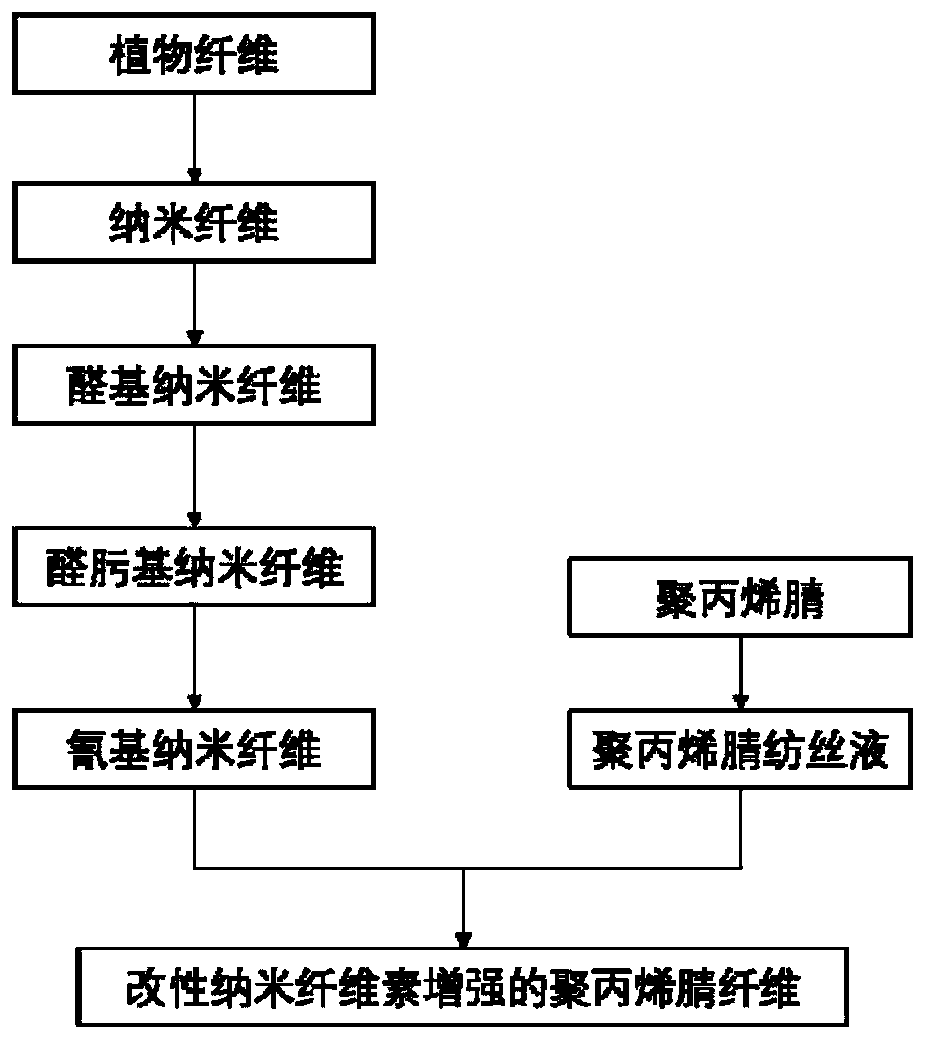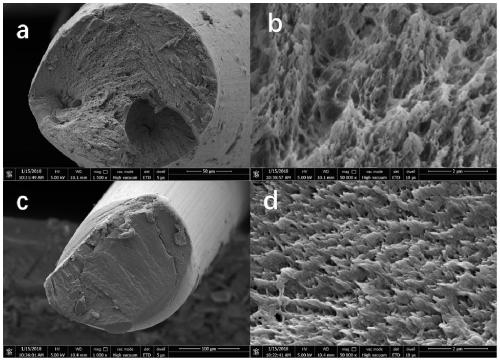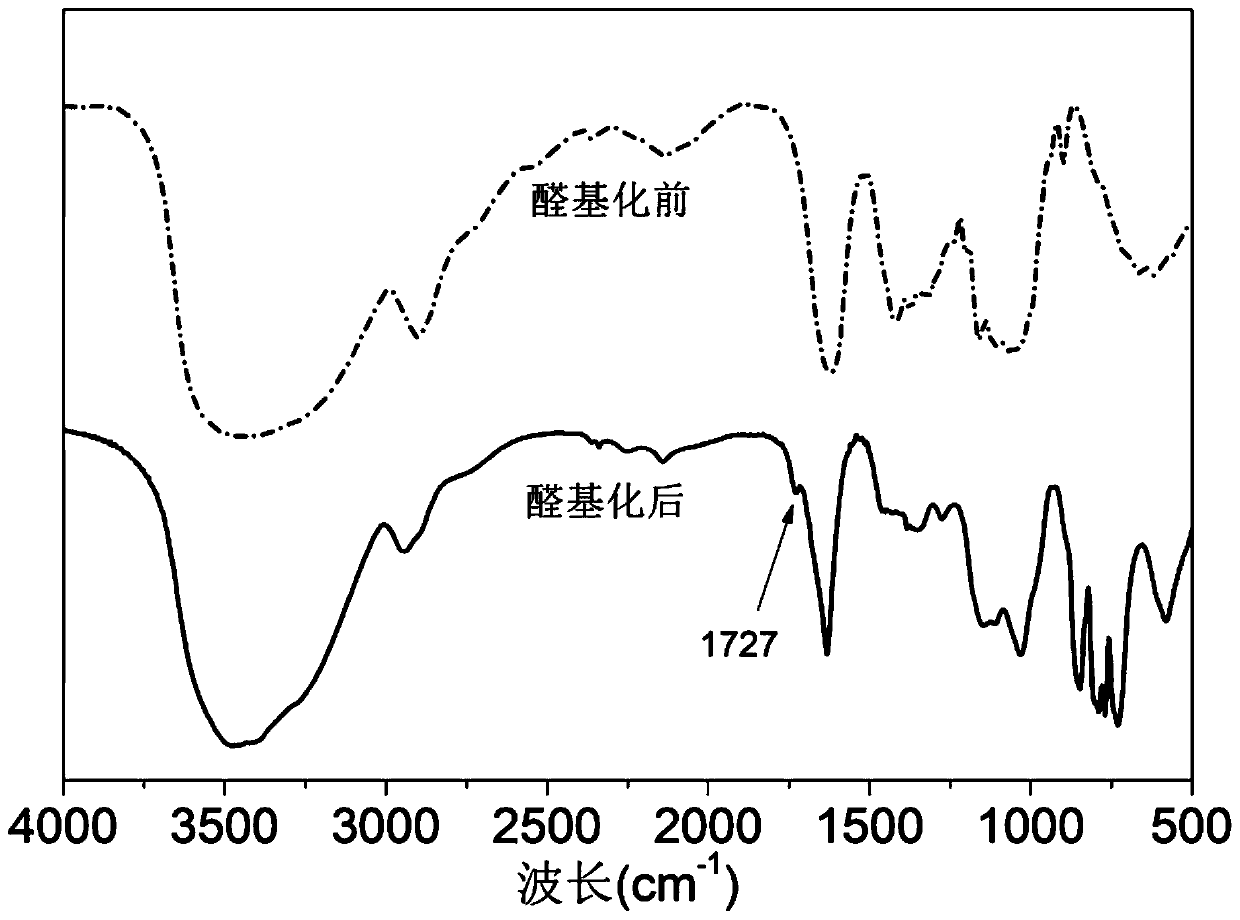Modified-nanometer-cellulose-enhanced polyacrylonitrile fiber and preparing method and application thereof
A polyacrylonitrile fiber and nanocellulose technology, applied in the direction of fiber chemical characteristics, rayon manufacturing, single-component synthetic polymer rayon, etc., to solve the problem of interface compatibility, expand uses, huge economic value and social benefit effect
- Summary
- Abstract
- Description
- Claims
- Application Information
AI Technical Summary
Problems solved by technology
Method used
Image
Examples
Embodiment 1
[0036] A modified nano-cellulose reinforced polyacrylonitrile fiber, the preparation method of which is as follows:
[0037] (1) Take bamboo fiber as raw material, and obtain nanocellulose after being processed several times with an ultrafine particle pulverizer. The treatment conditions of the ultrafine pulverizer are: the slurry concentration is 0.1%, the disc grinding gap is -100 μm, and the treatment times are 10 times.
[0038] (2) Oxidizing the C2 and C3 positions of the glucopyranose structural unit in the nanocellulose prepared in the step (1) with sodium periodate to generate cellulose with a 2,3-dialdehyde structure. The sodium periodate oxidation condition is: adding 1 g of sodium periodate to each gram of nanocellulose, reacting at 40° C. in the dark for 1 hour, and stirring at a speed of 100 r / min.
[0039] (3) Treat the cellulose with 2,3-dialdehyde structure prepared in step (2) with hydroxylamine hydrochloride at a temperature of 25°C for a period of time to o...
Embodiment 2
[0044] A modified nano-cellulose reinforced polyacrylonitrile fiber, the preparation method of which is as follows:
[0045] (1) Using straw fiber as a raw material, the nanocellulose is obtained after being processed several times with an ultrafine pulverizer. The treatment conditions of the ultrafine pulverizer are as follows: the slurry concentration is 20%, the disc grinding gap is 200 μm, and the treatment times are 10 to 100 times.
[0046] (2) Oxidizing the C2 and C3 positions of the glucopyranose structural unit in the nanocellulose prepared in the step (1) with sodium periodate to generate cellulose with a 2,3-dialdehyde structure. The sodium periodate oxidation condition is as follows: add 5 g of sodium periodate per gram of nanocellulose, react at 80° C. in the dark for 2 hours, and stir at a speed of 500 r / min.
[0047] (3) Treat the cellulose with 2,3-dialdehyde structure prepared in step (2) with hydroxylamine hydrochloride at a certain temperature for a period ...
Embodiment 3
[0052] A modified nano-cellulose reinforced polyacrylonitrile fiber, the preparation method of which is as follows:
[0053] (1) Take eucalyptus fiber as raw material, and obtain nanocellulose after being processed several times with an ultrafine pulverizer. The treatment conditions of the ultrafine pulverizer are: the slurry concentration is 10%, the disc grinding gap is -50 μm, and the treatment times are 50 times.
[0054] (2) Oxidizing the C2 and C3 positions of the glucopyranose structural unit in the nanocellulose prepared in the step (1) with sodium periodate to generate cellulose with a 2,3-dialdehyde structure. The sodium periodate oxidation condition is as follows: add 3 g of sodium periodate per gram of nanocellulose, react at 60° C. in the dark for 1 hour, and stir at a speed of 1000 r / min.
[0055] (3) Treat the cellulose with 2,3-dialdehyde structure prepared in step (2) with hydroxylamine hydrochloride at a certain temperature for a period of time to obtain cel...
PUM
| Property | Measurement | Unit |
|---|---|---|
| diameter | aaaaa | aaaaa |
| length | aaaaa | aaaaa |
| elastic modulus | aaaaa | aaaaa |
Abstract
Description
Claims
Application Information
 Login to View More
Login to View More - R&D Engineer
- R&D Manager
- IP Professional
- Industry Leading Data Capabilities
- Powerful AI technology
- Patent DNA Extraction
Browse by: Latest US Patents, China's latest patents, Technical Efficacy Thesaurus, Application Domain, Technology Topic, Popular Technical Reports.
© 2024 PatSnap. All rights reserved.Legal|Privacy policy|Modern Slavery Act Transparency Statement|Sitemap|About US| Contact US: help@patsnap.com










